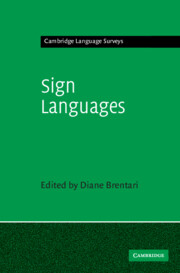Book contents
- Frontmatter
- Contents
- List of figures
- List of tables
- List of contributors
- List of sign language abbreviations
- Notational conventions
- 1 Introduction
- I HISTORY AND TRANSMISSION
- II SHARED CROSSLINGUISTIC CHARACTERISTICS
- 8 Notation systems
- 9 Verb agreement in sign language morphology
- 10 Functional markers in sign languages
- 11 Clause structure
- 12 Factors that form classifier signs
- 13 Handshape contrasts in sign language phonology
- 14 Syllable structure in sign language phonology
- 15 Grammaticalization in sign languages
- 16 The semantics–phonology interface
- 17 Nonmanuals: their grammatical and prosodic roles
- III VARIATION AND CHANGE
- Notes
- References
- Index
11 - Clause structure
from II - SHARED CROSSLINGUISTIC CHARACTERISTICS
Published online by Cambridge University Press: 05 June 2012
- Frontmatter
- Contents
- List of figures
- List of tables
- List of contributors
- List of sign language abbreviations
- Notational conventions
- 1 Introduction
- I HISTORY AND TRANSMISSION
- II SHARED CROSSLINGUISTIC CHARACTERISTICS
- 8 Notation systems
- 9 Verb agreement in sign language morphology
- 10 Functional markers in sign languages
- 11 Clause structure
- 12 Factors that form classifier signs
- 13 Handshape contrasts in sign language phonology
- 14 Syllable structure in sign language phonology
- 15 Grammaticalization in sign languages
- 16 The semantics–phonology interface
- 17 Nonmanuals: their grammatical and prosodic roles
- III VARIATION AND CHANGE
- Notes
- References
- Index
Summary
Introduction
This chapter is concerned with the clause structure of Brazilian Sign Language (LSB) and American Sign Language (ASL). In order to investigate clause structure, we devote some consideration to issues of basic and derived word order. These considerations allow us to formulate a proposed structure which captures the word order possibilities.
We find that LSB and ASL share a basic word order of Subject-Verb-Object (SVO). However, other word orders are also possible due to a variety of syntactic processes including topicalization, object shift and focus.
The chapter also discusses ways in which clause structure is different for sentences with agreeing verbs versus plain verbs (cf. chapters in this volume by Mathur and Rathmann and by Padden et al. on verb agreement). These differences motivate distinct phrase structures for sentences of the two types.
The structures in this chapter are presented using the terminology of generative syntax (see, among others, Chomsky 1995, Bošković & Lasnik 2007). We find that the formalism of this approach allows us to ask specific, detailed questions and make explicit proposals. The observations and generalizations we make are empirically based, however, and should be of interest to linguists using other approaches as well.
Our approach contributes to the overall goal of this volume by exploring the crosslinguistic similarities and differences between two geographically distinct sign languages. LSB and ASL have many similarities in word order and clause structure, but they also show intriguing differences.
- Type
- Chapter
- Information
- Sign Languages , pp. 225 - 251Publisher: Cambridge University PressPrint publication year: 2010
- 9
- Cited by

